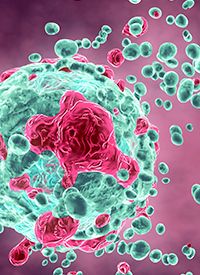Article
Rucaparib Significantly Improves PFS Over Chemo in Later-Line, BRCA+ Ovarian Cancer
Author(s):
December 21, 2020 - Rucaparib was found to result in a statistically significant improvement in progression-free survival compared with chemotherapy in patients with BRCA-mutant ovarian cancer who had previously received 2 or more lines of chemotherapy.

Rucaparib (Rubraca) was found to result in a statistically significant improvement in progression-free survival (PFS) compared with chemotherapy in patients with BRCA-mutant ovarian cancer who had previously received 2 or more lines of chemotherapy, meeting the primary end point of the phase 3 ARIEL4 trial (NCT02855944).1
Specifically, the PARP inhibitor (n = 220) achieved statistical significance over chemotherapy (n = 105) with regard to PFS per investigator assessment in the efficacy population (n = 325) with a hazard ratio (HR) of 0.639 (P = .0010). The median PFS in the investigative arm was 7.4 months compared with 5.7 months in the control arm.
Rucaparib (n = 233) also achieved statistical significance over chemotherapy (n = 116) in the intent-to-treat population (ITT; n = 349) per investigator-assessed PFS, with a HR of 0.665 (P = .0017). Here, the median PFS in the rucaparib and chemotherapy arms was also 7.4 months and 5.7 months, respectively.
“We are pleased with these topline results from the ARIEL4 trial, which confirm the clinical benefit of [rucaparib] vs chemotherapy, including platinum-based chemotherapy, as a treatment for women with BRCA mutation–positive advanced ovarian cancer, including patients who are platinum resistant,” Patrick J. Mahaffy, president and CEO of Clovis Oncology, stated in a press release. “We look forward to sharing comprehensive results at an upcoming medical meeting.”
The multicenter, phase 3 trial assessed rucaparib vs chemotherapy in patients with platinum-sensitive, partially platinum-sensitive, and platinum-resistant, relapsed ovarian cancer and a BRCA mutation who had previously received 2 or more lines of chemotherapy.
To be eligible for enrollment, patients had to be aged 18 years, have a histologically confirmed diagnosis of high-grade serous or grade 2 or 3 endometrioid epithelial ovarian, fallopian tube, or primary peritoneal cancer.2 Moreover, they had to have received 2 previous chemotherapy regimens and have either relapsed or progressed on treatment; this had to have been confirmed by radiologic evaluation.
Patients also needed to have disease that could be biopsied and examined and they needed to have acceptable archival formalin-fixed paraffin-embedded tumor tissue available for planned analyses.
If they had a history of prior cancers, they could not participate; however, those who had been curatively treated with no current evidence of cancer were permitted. Patients who had received previous treatment with a PARP inhibitor, who had symptomatic or untreated central nervous system metastases, or who had been hospitalized for bowel obstruction within 3 months before study enrollment, were excluded from the trial.
The primary end point of the trial was PFS per investigator assessment, with a step-down analysis from the efficacy population, if significant, to the ITT population.
A total of 349 patients were enrolled to the trial at clinical sites based in North America, South America, Europe, and Israel. Of these patients, 325 were included in the efficacy population, which included patient with a deleterious tumor BRCA mutation and excluded those with a BRCA reversion mutation as identified per a blood test developed by Guardant Health were excluded.
Additional results showed that participants who had a BRCA reversion mutation accounted for 7% of the entire study population, and these patients experienced limited clinical benefit with rucaparib, as anticipated.
Data from an interim analysis of overall survival (OS), with 51% of events having occurred in the ITT population, demonstrated a trend toward an advantage in the chemotherapy arm; however, this was confounded by the high rate of 64% of per-protocol crossover to [rucaparib] after disease progression on chemotherapy. Additionally, a trend toward an OS advantage with rucaparib at an point in the trial was observed in the ITT population vs those who did not receive the PARP inhibitor.
Regarding safety, the most frequently reported treatment-emergent grade 3/4 toxicities in all participants who received rucaparib included anemia/decreased hemoglobin (22%), neutropenia/decreased absolute neutrophil count (10%), asthenia/fatigue (8%), thrombocytopenia/decreased platelets (8%), and increased ALT/AST (8%).
“The ARIEL4 study verified that women with relapsed, BRCA mutation–positive advanced ovarian cancer, including those who are platinum-sensitive or -resistant, received benefit with rucaparib treatment when compared with chemotherapy,” Amit Oza, BSc, MD, MBBC, FRCPC, head of the division of Medical Oncology & Hematology, medical director of the Cancer Clinical Research Unit, co-director of the Drug Development Program, and senior scientist at Princess Margaret (PM) Cancer Centre, and professor of medicine at the University of Toronto, added in the release. “These results underscore the importance of rucaparib as a treatment option for women with BRCA-mutant advanced ovarian cancer.”
References
- Clovis Oncology’s Rubraca (rucaparib) met the primary endpoint of significantly improving progression-free survival vs chemotherapy in the ARIEL4 randomized phase 3 treatment study in later-line ovarian cancer patients with a BRCA mutation. News release. Clovis Oncology, Inc. December 21, 2020. Accessed December 21, 2020. http://bit.ly/2WynOyz.
- ARIEL4: a study of rucaparib versus chemotherapy BRCA mutant ovarian, fallopian tube, or primary peritoneal cancer patients. ClinicalTrials.gov. Updated December 10, 2020. Accessed December 21, 2020. https://clinicaltrials.gov/ct2/show/NCT02855944.









